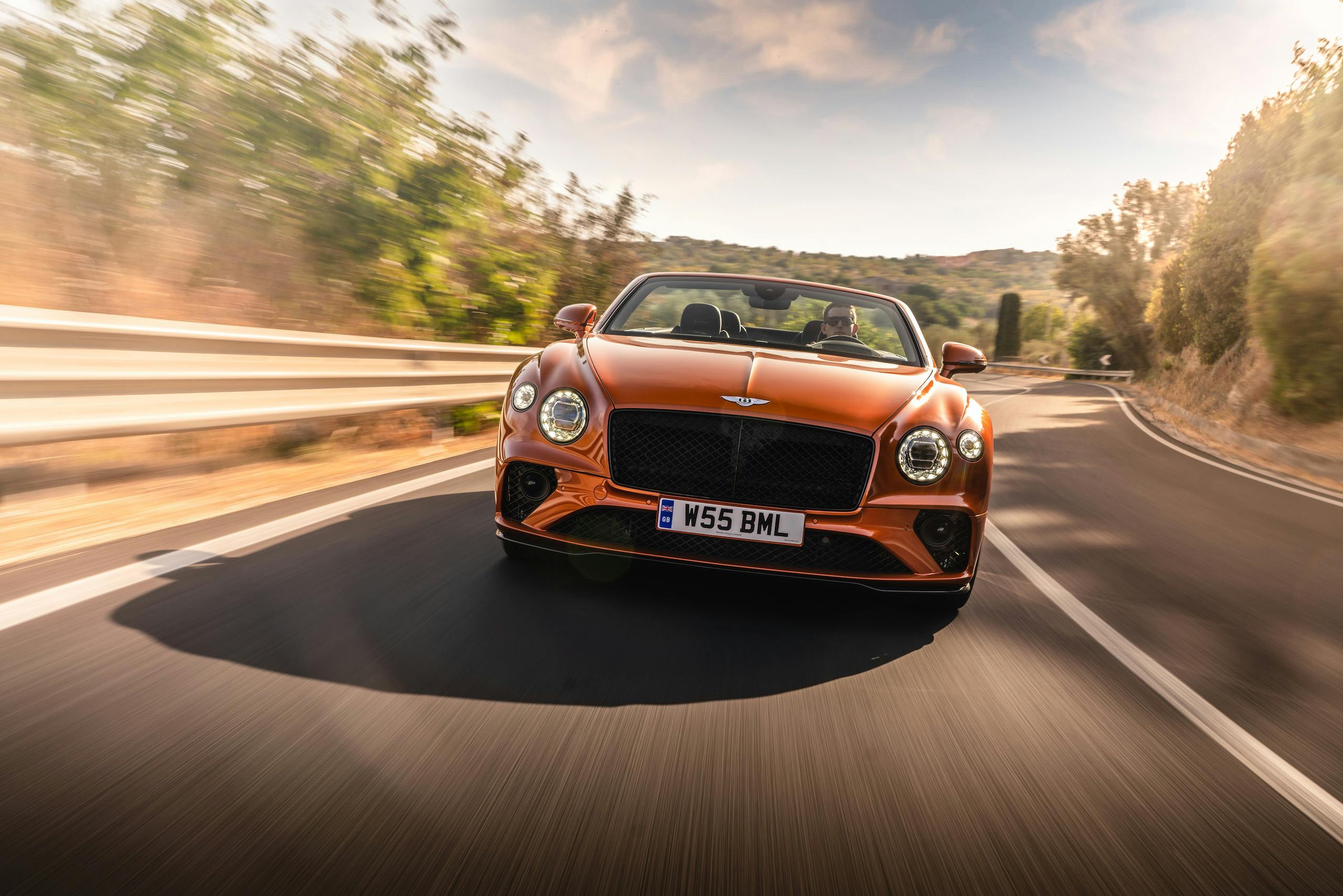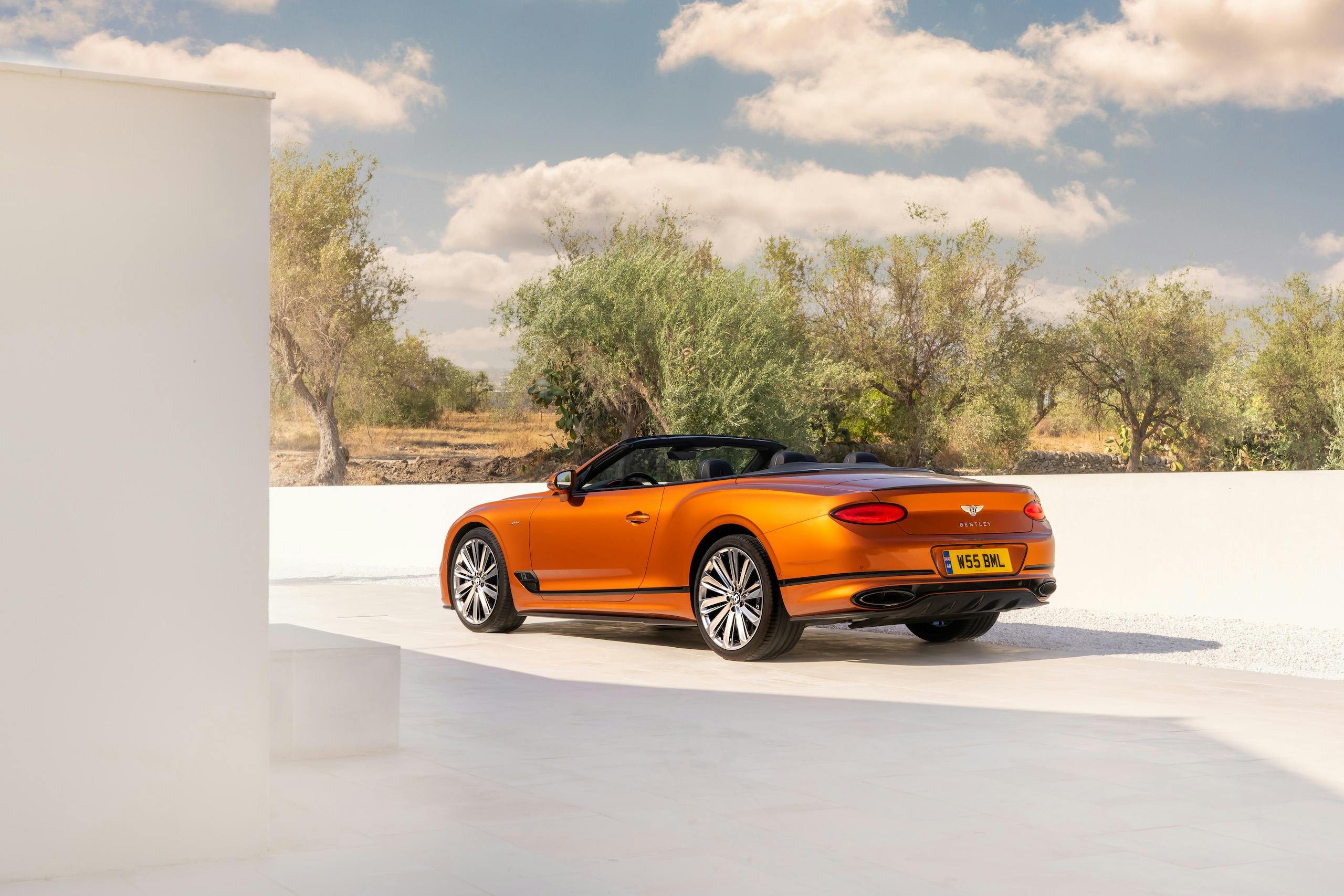Media | Articles
First Look Review: 2022 Bentley Continental GT Speed
The optional carbon-ceramic brakes on Bentley’s new Continental GT Speed cost about what you’d pay for a new Hyundai Elantra, but if your otherwise leisurely drive through a small town in Sicily is unexpectedly interrupted by an Italian fellow leaping into the road ahead, you’ll want to have spent the money. Our grasp of Italian isn’t what it used to be, but after we got a good solid panic stop out of the ten-piston front calipers a bit of handwaving and the scattershot use of a few other languages eventually made it clear: he wanted to know what, exactly, we were driving.
Well, sir, this is a Bentley Continental GT Speed. Let’s take it in order. Bentley, the brand once immortalized by David Ogilvy as being for people who were “too diffident to drive a Rolls-Royce” but wholly divorced from that other English motorcar brand since its acquisition by Volkswagen right before the turn of the century. Continental GT, the two-door variant of a car that was basically a fancy VW Phaeton until 2018 and is now a fancy Porsche Panamera. Big, fast, quiet, two and a half tons on the butcher’s scale, blunt and nasty like a bulldog’s face in early iterations but now rather graceful-looking, particularly in profile.

This much you probably know. Speed is the new part. In raw dragstrip terms, it’s hardly any faster than a standard twelve-cylinder Continental GT, adding 24 horsepower for a remarkable total of 650. Which is fine, because the, ahem, cooking variant is more than fast enough for almost anyone’s taste. What you get with your Speed badge is an additional focus on keeping that considerable straight-line urge in check.
There are four aspects to the Speed trim that deserve attention. The first, and biggest, change is all-wheel steering. At high speeds, it lightly steers the rear wheels to mimic the fronts. This allows you to change lanes with considerably more vigor, quite nice to have when you’re doing 150 km/h towards a bunch of little Fiats. Get down to walking pace, and the system will turn the rear wheels in the opposite direction to the fronts. If you’re trying to get back down a goat path or turn around in a cobblestone-lined town from the Renaissance or thereabouts, just to name two situations from our press drive, it’s very handy and does quite a bit to make this seven-foot-and-change-wide car maneuverable.
Next up: what Bentley claims are the largest brakes currently fitted to a production car. The first-generation Continental GT was notorious for literally setting its brakes on fire in certain enthusiastic situations, a natural consequence of its brutal inertia at triple-digit speeds. Changing platforms from the chunky old Phaeton to the modern-as-tomorrow VW Group MQB cuts some of the fat, which helps; Bentley quotes the new car at 5011lbs, which is a few hundred pounds lighter than the old model, but it’s not a Lotus Elise, or even two Lotus Elises. So the new system has 440mm front discs, clamped by ten pistons on each side. It stops in a hurry. You’ll meet a lot of friends in Sicily, many of whom are animals and many of whom are also interested in using the road. Our count: three separate cows, one horse, several chickens. All of these required a quick halt. Naturally, the real value of carbon-ceramics comes in weight savings (Bentley says almost seventy pounds) and fade resistance, which should be exemplary.
Marketplace
Buy and sell classics with confidence

The other two core features are electronic: a longer leash for the electronic stability control, including the ability to turn it off completely, and an electronic limited-slip differential. Combined with the usual all-wheel-drive VW Group theatrics, it’s hard to imagine ever spinning a wheel in this car, even if one wanted to.
It would be irresponsible to evaluate the difference between Continental GT and Continental GT Speed on public roads, even the roads of car-crazy Italy, so Bentley arranged for us to be taken around an abandoned airbase at something close to the speed of sound. Clearly the car is composed at velocities, g levels, and slip angles beyond the comfort level of all but the most Barnato-esque of potential owners. This is mostly irrelevant. Surely most buyers will take the Speed not because it has all-wheel steering or twenty-four extra horsepower but simply because it is above the standard car in the Bentley hierarchy, and if you’re in for a penny, why not go in for the 230,900 pounds required to procure our Orange Flame convertible, or the 209,900 of our Verdant hardtop example?

Here’s a bit of advice: get the convertible. The elaborate fabric roof is eerily quiet at high speeds, and it’s effortless to operate, so it has basically all the virtues of the hardtop plus the ability to enjoy the spaghetti-western weather of Italy (or Southern California). Aesthetically, it’s a neck-and-neck race with the plain coupe, a race easily won if you prefer the look of a contrast-color top.
We can’t stress enough that this GT Speed isn’t a replacement for the riotous GT3 Continental from a few years ago; that was a V8-powered car with extra attitude to go with a significant cost savings over its twelve-cylinder siblings. This GT Speed is simply a Continental with a little more of everything. The suggested interior decoration schemes are surprisingly conservative and do nothing to distract from the absolutely first-rate atmosphere behind the wheel. As with the standard car, there is both plenty of room for a 36-inch inseam up front and a close-coupled cockpit in which every control is within easy reach. The infotainment system deserves particular mention, as this was an Achilles’ heel of every Continental built between 2003 and 2017.
This is a level of automotive exuberance at which buyers are rarely price-conscious, or even competition-conscious. One struggles to imagine a customer deciding between this and, say, a Rolls-Royce Wraith. That being said, the newest Continental is much closer to Rolls-Royce pricing than ever before. A plain Speed GT hardtop will require $274,900, but if you want the nice brakes and the Naim sound system, expect to pay more. The convertible starts at $302,000. This is more or less Wraith and Dawn territory, but those cars are leaving the market at the end of this year, a felicitous occurrence indeed for Bentley.
This newest Continental GT Speed effectively fulfills the promise not quite honored by its 2003 predecessor: a personal-sized Bentley with prodigious power and the ability to make cobblestones disappear beneath its massive wheels, comfortable and coddling in all situations. It’s even handsome, but don’t take our word for it; ask the fellow who risked his life to learn more. Now, would anyone do that for a Hyundai Elantra?











































































